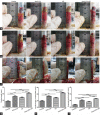Anti-lysyl oxidase combined with a vacuum device induces penile lengthening by remodeling the tunica albuginea
- PMID: 31736474
- PMCID: PMC7523611
- DOI: 10.4103/aja.aja_120_19
Anti-lysyl oxidase combined with a vacuum device induces penile lengthening by remodeling the tunica albuginea
Abstract
This study aimed to explore whether and how anti-lysyl oxidase (anti-LOX) combined with a vacuum device (VD) could promote penile lengthening and to evaluate the effect on erectile function. This study was performed on four groups of adult rats: control, anti-LOX, VD (negative pressure value of -300 mmHg), and anti-LOX + VD. Penile length was measured by a modified VD method and verified on exposed length data. Intracavernous pressure (ICP) and maximum ICP/mean arterial pressure (MAP) ratio were recorded to assess erectile function. For corpus cavernosum, LOX activity and concentrations of pyridinoline, desmosine, hydroxyproline, and elastin were analyzed; transmission electron microscope and Hart's elastin staining were performed to monitor microstructural changes. Anti-LOX and VD significantly lengthened the penis by 10.8% (3.75 mm) and 8.2% (2.48 mm) compared with the control group, respectively, while anti-LOX + VD achieved the longest penile size (40.58 ± 0.40 mm) which was 17.4% longer than the control group (34.58 ± 0.54 mm). After 1-week washout, no penile retraction was observed. Meanwhile, exposed penile length data confirmed that the penis in the anti-LOX + VD group was also significantly longer. Anti-LOX inhibited LOX activity to reduce pyridinoline level, which led the penile tunica albuginea remodeling. However, it had no effect on hydroxyproline, desmosine, and elastin levels. Moreover, anti-LOX had no impact on erectile function, which was determined by ICP and ICP/MAP ratio. These results suggest that anti-LOX elongates the penis by reducing pyridinoline, which induces tunica albuginea remodeling. This lengthening effect was more obvious when combined with a VD. All procedures had no impact on erectile function.
Keywords: anti-lysyl oxidase; crosslinking; penile lengthening; tunica albuginea remodeling; vacuum device.
Conflict of interest statement
None
Figures






Similar articles
-
HCG supplement did not accelerate tunica albuginea remodeling to facilitate penile growth.Sci Rep. 2023 Oct 2;13(1):16519. doi: 10.1038/s41598-023-38888-y. Sci Rep. 2023. PMID: 37783699 Free PMC article.
-
Characteristics of penile growth in pubertal rats and a non-invasive method to lengthen the penis.Andrology. 2020 Nov;8(6):1884-1894. doi: 10.1111/andr.12845. Epub 2020 Jul 12. Andrology. 2020. PMID: 32578359
-
Amelioration of Cavernosal Fibrosis and Erectile Function by Lysyl Oxidase Inhibition in a Rat Model of Cavernous Nerve Injury.J Sex Med. 2018 Mar;15(3):304-313. doi: 10.1016/j.jsxm.2018.01.011. J Sex Med. 2018. PMID: 29502979
-
Enlargement of length and girth associated with implantation of penile prostheses.Actas Urol Esp (Engl Ed). 2020 Jun;44(5):333-339. doi: 10.1016/j.acuro.2019.10.015. Epub 2020 Apr 9. Actas Urol Esp (Engl Ed). 2020. PMID: 32278614 English, Spanish.
-
Lysyl oxidases: from enzyme activity to extracellular matrix cross-links.Essays Biochem. 2019 Sep 13;63(3):349-364. doi: 10.1042/EBC20180050. Print 2019 Sep 13. Essays Biochem. 2019. PMID: 31488698 Review.
Cited by
-
HCG supplement did not accelerate tunica albuginea remodeling to facilitate penile growth.Sci Rep. 2023 Oct 2;13(1):16519. doi: 10.1038/s41598-023-38888-y. Sci Rep. 2023. PMID: 37783699 Free PMC article.
References
-
- Ghanem H, Glina S, Assalian P, Buvat J. Position paper: management of men complaining of a small penis despite an actually normal size. J Sex Med. 2013;10:294–303. - PubMed
-
- Tomova A, Deepinder F, Robeva R, Lalabonova H, Kumanov P, et al. Growth and development of male external genitalia: a cross-sectional study of 6200 males aged 0 to 19 years. Arch Pediatr Adolesc Med. 2010;164:1152–7. - PubMed
-
- Vardi Y. Is penile enlargement an ethical procedure for patients with a normal-sized penis? Eur Urol. 2006;49:609–11. - PubMed
-
- Nugteren HM, Balkema GT, Pascal AL, Schultz WC, Nijman JM, et al. Penile enlargement: from medication to surgery. J Sex Marital Ther. 2010;36:118–23. - PubMed
-
- Colombo F, Casarico A. Penile enlargement. Curr Opin Urol. 2008;18:583–8. - PubMed
Publication types
MeSH terms
Substances
LinkOut - more resources
Full Text Sources

